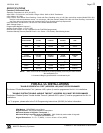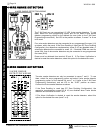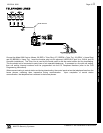
L NAPCO Security Systems
Freedom F-64 Installation Instructions
WI1501A 9/06
Page 9
Wiring
Wire Touchpad(s), zones, expansion zone modules and output devices as shown on the Wiring Diagram. Note that
the Wiring Diagram contains important information not available elsewhere in this manual.
Adding Expansion Zones
The F-64 control panel can support up to 16 zones as is, however this number may be increased to as many as 64
programmable zones using optional expansion zone modules (EZMs).
Wireless Systems
With the addition of at least one GEM-RECV series receiver, the F-64 will support up to 64 wireless transmitters. The
panel can accommodate one or two receivers within the premises, responding to the one with the stronger transmitter
signal. If any transmitters are selected for the default program, a GEM-RECV receiver will automatically be
programmed.
The Touchpad can display the status of any transmitter, indicating the condition of the zone (normal or open) and
transmitter troubles (low battery, tamper or supervisory failure), and signal strength of the last transmission. A receiver
failure will be indicated by “E06-NN” (“no response”, with NN representing the receiver number).
TYPICAL RESIDENTIAL FIRE INSTALLATION
(Where permitted by local codes)
At least one smoke detector should be installed directly outside
each sleeping area. If there is more than one floor, additional
smoke detectors should be installed on each level, including the
basement. The living-area and basement smoke detectors
should be installed near the stairway of the next upper level.
For increased protection, additional detectors should be installed
in areas other than those required, such as the dining room,
bedrooms, utility room, furnace room, and hallways. Heat
detectors, rather than smoke detectors, are recommended in
kitchens, attics, and garages due to conditions that may result in
false alarms and improper operation. Large areas and areas with
partitions, ceiling beams, doorways, and open joists will require additional detectors.
Refer to NFPA Standard No. 74 (National Fire Protection Association, Batterymarch Park, Quincy, MA 02269) for
additional information, including proper mounting of detectors.
TYPICAL PARTITIONED INSTALLATION
(4 Partitions Available) The system supports (4) areas but only areas 1 and 2
support Touchpads. In addition, Touchpads can only control the area to which
they are assigned.
Described and illustrated here are an example of a partitioned
system with common-area protection of the control-panel room. This
system meets UL requirements for a partitioned system.
All areas must be owned and managed by the same person(s).
All areas must be part of one building at one street address.
The control panel and all wiring protecting each partitioned area
must be confined to the respective area and may not impinge upon the
other areas. This requires that the control panel room have redundant
protection; that is (a) multiple sets of door contacts, each wired to a
separate zone and (b) one of those zones programmed for each area. In order to gain access to this protected
area without causing an alarm, both partitions must be disarmed. In lieu of redundant protection, 24-Hour Zones
may be used. Any zone protecting the control panel and transformer may not be programmed for bypass.
The sounding device must be placed such that the bell test can be heard by all partitions. Note: NFPA 74
(Household Fire Warning Equipment) requires that a fire alarm audible device be installed indoors.
The User
Program Code is not to be given to anyone except the authority responsible for all partitions.
CAUTION: Do not run telephone wiring near speaker wires; do not run keypad / Touchpad wiring with loop wiring.
Wiring


















